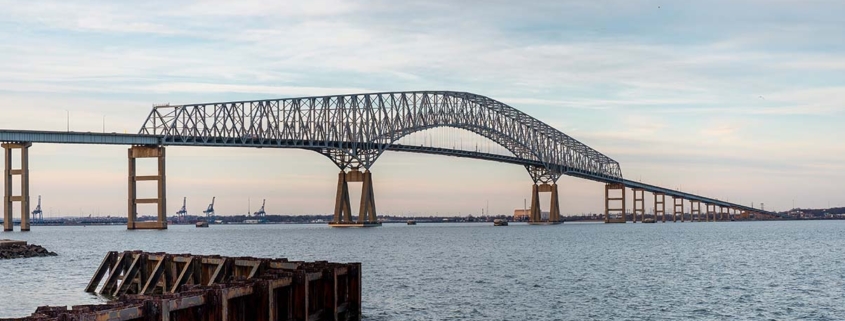The Francis Scott Key Baltimore Bridge Collapse Tragedy: A Devastating Collision and Its Aftermath
This is an ongoing story and we’ll update as facts come out about the story.
In the predawn hours of a fateful Tuesday morning, the city of Baltimore was thrust into turmoil as a colossal container ship, adrift and powerless, careened towards the iconic Francis Scott Key Bridge. Despite desperate efforts to avert disaster, the vessel’s collision with one of the bridge’s support columns shattered the tranquility of the night, plunging a vital mid-Atlantic thoroughfare into the frigid depths of the Patapsco River. In the aftermath, the city grappled with the enormity of the tragedy, declaring states of emergency as search-and-rescue efforts unfolded amidst the chaos and devastation.
The Francis Scott Key bridge collapse is a tragedy that has touched us all both near and far. Our thoughts and prayers are with the victims, their families, and the entire community of Baltimore as they cope and navigate this devastating event.
The U.S. Bridge Team
What We Know of the Baltimore Bridge Collapse
The Incident at the Francis Scott Key Bridge
- A massive container ship lost power and collided with the Francis Scott Key Bridge in Baltimore.
- The collision resulted in a section of the bridge collapsing into the Patapsco River.
- Several vehicles were knocked into the water, and search-and-rescue efforts were initiated to locate missing individuals.
The Ship and Crew
- The vessel, named Dali, was built in 2015 and had arrived from Norfolk, Virginia.
- All 22 crew members and two pilots aboard the ship were safely accounted for, with no reported injuries.
- The ship had a previous collision incident in the Port of Antwerp in Belgium in July 2016.
Immediate Response
- States of emergency were declared by both the mayor and governor of Baltimore.
- Search-and-rescue operations were launched to locate missing individuals and assess the extent of the damage.
Investigation and Findings
- Initial assessments indicated that the bridge had been fully compliant with safety regulations.
- Speculation regarding the cause of the collision centered around a potential engine problem on the ship.
- Structural engineers found no immediate red flags regarding the bridge’s integrity.
Community Response
- Residents and officials expressed shock and grief over the incident, emphasizing the importance of infrastructure safety.
- Efforts were made to mitigate traffic disruptions and provide alternative routes for commuters.
Officials stopped cars from crossing the Francis Scott Key Bridge just moments before the cargo ship collided
Not according to this video…Vehicles are clearly crossing the bridge right up to impact.https://t.co/Jdo2nbWFz5
— 🇺🇸 Pismo 🇺🇸 (@Pismo_B) March 26, 2024
Baltimore Bridge Collapse Details Emerging
As authorities scrambled to piece together the events leading up to the collision, details emerged shedding light on the vessel’s journey. Built in 2015, the ship had arrived from Norfolk, Virginia, before departing from the Port of Baltimore shortly before the collision. Despite the scale of the catastrophe, all 22 Indian crew members and two pilots aboard the vessel were safely accounted for, with no reports of injuries.
The incident reignited concerns about the ship’s safety record, with reports of a previous collision in the Port of Antwerp in Belgium in July 2016. However, the immediate focus remained on the search-and-rescue operation, with Senator Ben Cardin emphasizing the limited number of occupied vehicles on the bridge at the time of the collision.
Amidst fears of environmental damage, authorities reassured the public that there had been no pollution from the incident, although there were reports of a diesel fuel odor. Efforts to mitigate traffic disruptions included directing vehicles to alternative routes, with hazardous materials transports advised to avoid tunnels.
As investigations into the cause of the collision unfolded, initial assessments indicated that the bridge had been fully compliant with safety regulations. Despite speculation, structural engineers found no immediate red flags regarding the bridge’s integrity, attributing the collapse to an acute event rather than underlying structural issues.
Hope in the Aftermath of the Francis Scott Key Baltimore Bridge Collapse
Sal Mercogliano, a Campbell University professor and former merchant mariner, suggested an engine problem as a potential cause, highlighting the catastrophic consequences of power loss on a vessel. The Key Bridge, a testament to Maryland’s rich history, stood as a symbol of resilience and unity, its collapse leaving a void in the city’s landscape.
Before daybreak Tuesday, 50-year-old Lupe Lucas and her son stood along the water’s edge in Dundalk, their eyes fixed on the desolate scene where the majestic Francis Scott Key Bridge once spanned the Patapsco River. The center of the bridge had vanished, leaving behind only a haunting reminder—a section collapsed atop the massive, motionless vessel.
“As the sun rises, and there’s nothing there,” Lupe lamented, her voice heavy with sorrow, “that’s going to be heartbreaking for a lot of people.” Her words echoed the sentiments of many in the community, encapsulating the profound sense of loss and disbelief that enveloped Baltimore in the wake of the tragedy.
In the silence of the early morning hours, Lupe and her son bore witness to the stark reality of destruction, grappling with the enormity of the catastrophe that had befallen their city. Yet, amidst the wreckage, there was a glimmer of resilience—a resolve to rise above adversity and rebuild what had been lost.
Their presence along the water’s edge was a testament to the indomitable spirit of Baltimore—a spirit that would endure, even in the face of unimaginable devastation. As they stood, gazing at the remnants of the bridge, Lupe and her son embodied the strength and solidarity that would guide the city on its path to recovery.
With each passing moment, as the sun cast its first rays upon the fractured landscape, they found solace in the promise of a new day—a day filled with hope, resilience, and the unwavering determination to rebuild what had been lost.



